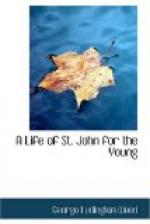John recorded seven miracles of our Lord. The first was that of turning water into wine. The last was the raising of Lazarus. In both of them He points us to the same glorious purpose. He says that in the first, Christ “manifested forth His glory,” and that the second was “for the glory of God, that the Son of God might be glorified thereby.” And now standing with Martha by the yet unopened tomb, John hears their Lord remind her of His assurance that if she believed, she “should see the glory of God.” That hour had come. The Lord had commanded, “Take ye away the stone.” John was most attentive to every act of the passing scene. His eyes glanced from the stone to his Lord. As soon as the command concerning it was obeyed Jesus lifted His eyes upward, and said, “Father”—calling upon Him with whom He was to be glorified.
John had stood at the bedside of the only daughter of Jairus, and heard the command, “Damsel, I say unto thee, Arise.” By the bier of the widow’s only son he had probably heard that other, “Young man, I say unto thee, Arise.” And now standing by the open door of the tomb of the only brother, was He not listening for a like command? He had not long to wait. The prayer of his Lord was ended. The tone of prayer was changed to that of command. “He cried with a loud voice, Lazarus come forth. And he that was dead came forth.” John describes his appearance. He was “bound hand and foot with grave clothes, and his face was bound about with a napkin.” When Jesus saith unto them, “Loose him and let him go”—away from the excitement and curiosity of the heartless mourners—who was so ready as John to obey the command, while welcoming his friend back to life? Who could so fittingly escort him from the darkened tomb to the relighted home, with the sisters still weeping—but for joy.
In John’s old age when he recalled this resurrection scene, he seems to have had a special memory of the younger sister’s sorrow. He speaks of the “Jews which came to Mary” in the hour of her sadness.
But His memory of that resurrection day was tinged with gloom. He traced back, from the cross on Calvary to the tomb in Bethany, the way by which his Lord had been led by His enemies. “From that day forth they took counsel together for to put Him to death.”
[Illustration: THE RESURRECTION OF LAZARUS Old Engraving Page 126]
It is tradition, not John, which tells us concerning Lazarus that the first question which he asked Christ after He was restored to life was whether He must die again; and that being told that he must, he was never more seen to smile. But John, better than tradition, tells of another scene in which we imagine his smiles were not restrained. To it let us turn.
CHAPTER XIX
John’s Memorial of Mary
“When Jesus was
in Bethany, ... there came unto Him a woman having
an alabaster cruse of
exceeding precious ointment, and she poured
it upon his head, as
He sat at meat.”—Matt. xxvi.
6, 7.




